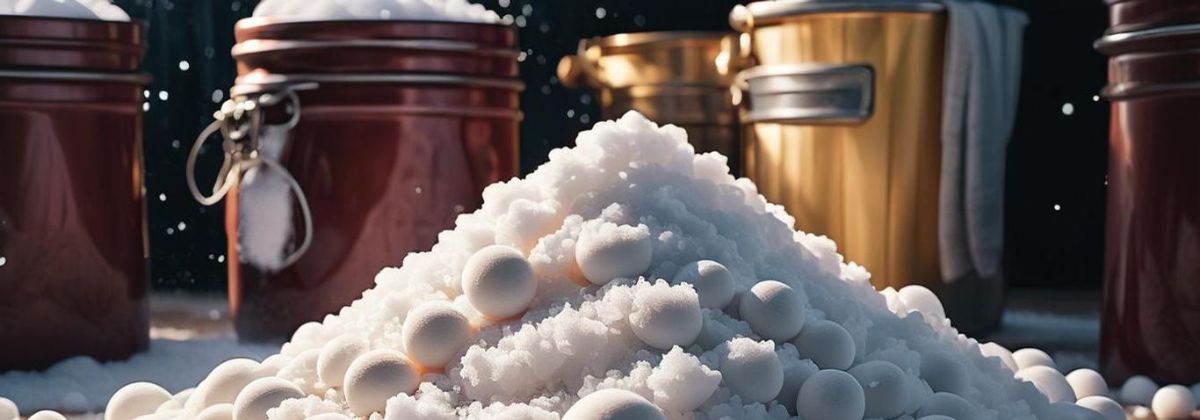20 Apr Salt in Laundry: Enhancing Your Laundry Routine
Suppose you’ve sought straightforward yet efficient methods to upgrade your laundry routine. In that case, you may have encountered the recommendation to incorporate salt into your washing process. While it might appear unorthodox, salt can potently aid your pursuit of fresher clothes. From amplifying detergent efficacy to combating resilient stains, salt boasts a variety of advantages that render it a valuable inclusion in any laundry regimen. Let’s see how salt in the laundry can help you!
What is Salt in Laundry?
The typical household ingredient in laundry is sodium chloride or table salt. While it’s primarily known for its culinary uses, salt can also benefit the laundry process. When added to the washing machine, salt can help enhance the cleaning power of detergents, improve fabric colour retention, soften hard water, and aid in removing stains and odours from clothing and linens.
Types of Salt Used in Laundry
There are several types of salt commonly used in laundry, each with its own unique properties and benefits:
- Table Salt: Table salt, or sodium chloride, is the most readily available type of salt and is commonly used in households worldwide. It enhances the cleaning power of detergents and can help remove stains and odours from fabrics.
- Epsom Salt: Epsom salt, or magnesium sulfate, is another popular laundry option. It is prized for its ability to soften fabrics and alleviate odours. It benefits towels, linens, and other items close to the skin.
- Rock Salt: Coarser than table salt, rock salt is a natural abrasive. It helps to scrub away dirt and grime from fabrics. While less commonly used than table salt or Epsom salt, it can still be effective in specific laundry applications, particularly for heavily soiled items.
Benefits of Using Salt in Laundry
Using salt in laundry offers several benefits that can enhance the effectiveness of your washing routine:
- Enhanced Cleaning Power: Salt helps to boost the cleaning power of laundry detergents by softening water. Soft water allows detergents to lather more effectively and penetrate fabrics more deeply, resulting in cleaner clothes.
- Colour Preservation: Salt can help prevent colours from fading during washing. By stabilising the pH level of the water, salt helps to lock in colour and prevent dyes from bleeding, keeping your clothes looking vibrant and new for longer.
- Softening Hard Water: In regions with hard water that have high levels of minerals such as calcium and magnesium, salt can help soften the water. Soft water is more accessible to lather with detergent. It rinses off more efficiently, which reduces the possibility of mineral buildup on clothes and washing machine parts.
- Stain Removal: Salt can be used as a pre-treatment for stubborn stains. Its abrasive nature helps to loosen dirt and grime from fabrics, making it easier for detergents to lift away stains during the wash cycle.
- Odour Elimination: Salt effectively neutralises unpleasant odours in clothing and linens. By absorbing moisture and odour-causing bacteria, salt helps freshen fabrics and leaves them smelling clean and fresh.
- Fabric Softening: When added to the wash cycle, salt can help to soften fabrics and reduce stiffness. This benefits towels, linens, and other items that may become rough or scratchy after repeated washings.
How to Use Salt
Using salt in laundry is a simple and effective way to reap its benefits, and there are various ways to do it:
- Pre-treat Stains: Before washing, create a paste by mixing salt with water and applying it directly to stubborn stains. Let it sit for a few minutes to penetrate the fabric before laundering as usual.
- Add to Wash Cycle: Add a tablespoon of salt to your washing machine and your regular laundry detergent. The salt will enhance the detergent’s cleaning power and improve overall results.
- Soak Fabric: For heavily soiled items or those with lingering odours, consider soaking them in water and salt before laundry. Soaking can help loosen dirt and grime and make it easier for the detergent to remove stains and odours during the wash cycle.
- Brighten Whites: To brighten white fabrics, soak them in warm water and salt before washing them. This can help remove yellowing and discolouration, leaving your whites brighter and cleaner.
- Fabric Softening: Add salt to your washing machine’s rinse cycle. It helps soften fabrics, particularly towels, linens, and other items that may become stiff or rough after washing.
- Odour Elimination: If you’re washing particularly smelly items, such as workout clothes or pet bedding, add a tablespoon of salt to the wash cycle to help neutralize odours and leave fabrics smelling fresh.
Removing Stains with Salt
Removing stains with salt is a handy and effective technique for tackling various stains. Here’s how you can use salt to target specific stains:
- Blood Stains: Immediately soak the affected fabric in cold water for fresh blood stains. Once soaked, create a paste using salt and cold water, then apply it directly to the stain. Leave it for about 15 minutes before rinsing it with cold water. Repeat the process if necessary until the stain is removed.
- Sweat Stains: To remove yellowing or discolouration caused by sweat stains, mix equal parts salt and water to create a paste. So, apply the paste to the affected area and gently rub it into the fabric. As usual, let it sit for at least 30 minutes before laundering. Also, add a tablespoon of salt to the wash cycle for stubborn stains to help lift the discolouration.
- Wine Stains: If you’ve spilt wine on clothing or fabric, blot the stain with a clean cloth or paper towel. This way, you can absorb as much liquid as possible. Then, cover the stain with a generous amount of salt and let it sit for several hours or overnight. The salt also helps to absorb the remaining moisture and lift the stain from the fabric. Afterwards, rinse the fabric with cold water and launder as usual.
- Grease Stains: For grease or oil stains, sprinkle salt onto the stain. Then, let it sit for a few hours. Afterwards, brush off the salt and treat the remaining stain with a pre-wash stain remover or laundry detergent before laundering.
- Ink Stains: If you’ve accidentally gotten ink on clothing or fabric, immediately cover the stain with salt to help absorb the ink. Let it sit for a few hours, then brush off the salt and treat the remaining stain.
Precautions When Using Salt
While using salt in laundry can be beneficial, taking certain precautions to ensure the best results and avoid potential issues is essential. Here are some precautions to keep in mind:
- Colourfastness: Before using salt on coloured fabrics, incredibly dark or vibrant colours, it’s crucial to test a small, inconspicuous area first. This helps ensure that the salt won’t cause any colour bleeding or fading that could damage the fabric.
- Sensitive Skin: If you or anyone in your household has sensitive skin, be cautious when using salt in laundry. While salt is generally safe for most fabrics, it can sometimes cause irritation or discomfort, especially if the fabric touches the skin.
- Overuse: Avoid using excessive amounts of salt in your laundry. While salt can be effective in small quantities, using too much can lead to a buildup of residue on your clothes, washing machine, and plumbing. Additionally, excessive salt usage may not provide additional benefits and could damage fabrics over time.
- Compatibility with Detergents: While salt can enhance the cleaning power of detergents, it’s essential to ensure compatibility with any other laundry products you may be using. Certain additives or ingredients in detergents may not react well with salt, so it’s best to check the manufacturer’s recommendations or consult a professional if you need more clarification.
- Environmental Impact: While salt itself is natural and biodegradable, excessive use or disposal of saltwater can have ecological implications, especially if it ends up in freshwater bodies. Be mindful of how much salt you use in your laundry and avoid unnecessary waste or runoff.
The Last Word
Incorporating salt into your laundry routine can have many benefits, from enhancing cleaning power to preserving colours and fabrics. Whether dealing with stubborn stains or simply looking to freshen up your laundry, salt is a versatile and affordable solution that deserves a place in your laundry room.




Sorry, the comment form is closed at this time.